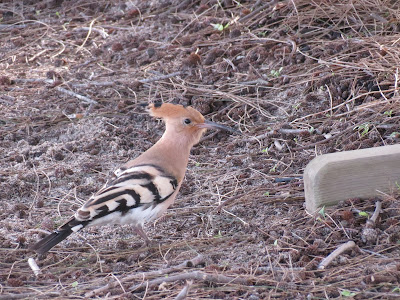Laguna de Fuente de Piedra is the largest natural lake in Iberia (6.5 x 2.5 km), but is incredibly shallow, rarely more than a metre deep. It dries up to a huge degree in the summer months, and indeed was too shallow when we visited for the huge flocks of ducks we were hoping for.
This site is home to the second largest Greater Flamingo colony in Europe (although numbers vary massively based on water levels). We did see large numbers here, but views were very distant, as all the viewpoints over the lake were disappointingly far from the water. Still, I did get a reasonable video showing the funny way these birds feed.
Luckily, we later visited a site where some 2000 flamingos could be seen much closer.
Quite a few White Storks were mixed in. Stork nests adorned hydro poles and buildings throughout our trip except in mountainous areas.
The highlight here was running into a British expat birder who ended up
showing us around his local area for three hours - serious hospitality!
The best bird here was our only Black-winged Kite of the trip. These
little raptors are bizarrely short-tailed with tern-like flight.
One of the major highlights of the trip was seeing a number of Hoopoe (Hoopoes?). This unique bird has no close relatives, but is probably somewhat related to the hornbills.
As you can see, they can become somewhat tame!
Zitting Cisticolas strongly reminded me of Sedge wrens in appearance and behaviour, although they aren't nearly as secretive. They also have an awesome common name!
European Stonechat was probably the most frequently seen bird in any open habitat.
This odd succulent plant dominated the rocky coasts of Portugal.
We eventually found out that it is Hottentot Fig - a serious invasive species!
Dragonflies seen included a variety of small meadowhawk-like skimmers as well as various darners. The only species conclusively identified was this one that washed up dead in the surf at the end of our trip - a Blue Hawker (Aeshna cyanea).
On our final day we unexpectedly came across a sign pointing out these dinosaur footprints presrved in a cliff face. It's hard to tell from the picture but the prints are bigger than a dinner plate.
And that was it! For those interested in that kind of thing, we had 128 species of birds, of which 108 were lifers for me. Several of the subspecies were new too - Green-winged Teal, Great Egret, Whimbrel and possibly others. The full list is below, with lifers in bold:
Gadwall, Eurasian
Wigeon, Mallard, Northern Shoveler, Northern Pintail, Green-winged Teal, Common Pochard, Red-legged Partridge, Little Grebe,
Great Crested Grebe, Greater
Flamingo, Cory's Shearwater, Balearic Shearwater, White Stork,
Northern Gannet, Great Cormorant, European Shag, Gray Heron, Great Egret,
Little Egret, Cattle Egret, Glossy Ibis,
Eurasian Spoonbill, Osprey,
Black-shouldered Kite, Eurasian Griffon, Booted Eagle,
Eurasian Marsh-Harrier, Eurasian
Sparrowhawk, Red Kite, Common Buzzard, Western Swamphen, Eurasian Moorhen, Eurasian Coot, Common Crane,
Eurasian Thick-knee, Black-winged
Stilt, Pied Avocet, Black-bellied Plover, Northern
Lapwing, Kentish Plover, Common Ringed Plover, Common Sandpiper, Green Sandpiper, Common Greenshank, Common Redshank, Whimbrel,
Eurasian Curlew, Black-tailed Godwit, Ruddy Turnstone, Red
Knot, Sanderling, Dunlin,
Little Stint, Common Snipe,
Great Skua, Jaeger sp., Razorbill, Black-headed Gull, Mediterranean Gull, Audouin's Gull, Yellow-legged Gull, Lesser Black-backed Gull, Caspian Tern,
Sandwich Tern, Rock Pigeon, Common
Wood-Pigeon, Eurasian Collared-Dove, Eurasian Hoopoe, Common Kingfisher, Eurasian Kestrel, Peregrine Falcon, Southern
Gray Shrike, Eurasian Jay, Iberian Magpie, Eurasian Magpie, Red-billed Chough, Eurasian Jackdaw, Carrion Crow,
Common Raven, Crested Lark, Thekla Lark,
Eurasian Crag-Martin, Coal Tit, Crested Tit,
Eurasian Blue Tit, Great Tit, Long-tailed Tit, Short-toed Treecreeper, Eurasian Wren, Goldcrest,
Firecrest, Cetti's Warbler, Common Chiffchaff, Zitting Cisticola, Eurasian Blackcap, Sardinian Warbler, Dartford Warbler, Spotted Flycatcher, European Robin, Bluethroat,
European Pied Flycatcher, Black
Redstart, Blue Rock-Thrush, European Stonechat, Black Wheatear, Northern Wheatear, Eurasian Blackbird, Song Thrush,
Spotless Starling, Alpine
Accentor, Dunnock, Gray Wagtail,
White Wagtail, Meadow Pipit, Cirl Bunting,
Rock Bunting, Corn Bunting, Common Chaffinch, Brambling,
European Greenfinch, Eurasian
Siskin, European Goldfinch, Eurasian Linnet, European Serin, House Sparrow, Spanish
Sparrow, Common Waxbill, Scaly-breasted Munia














No comments:
Post a Comment